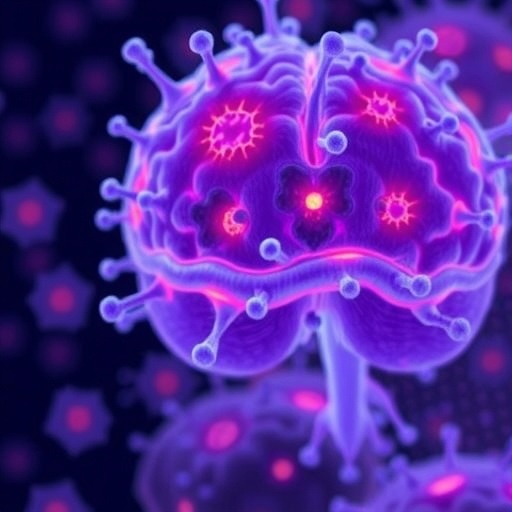Recent advancements in the field of neurodegenerative diseases have significantly illuminated the role of extracellular Tau in the progression of Alzheimer’s disease. As a key player in the pathophysiology of this debilitating condition, the accumulation of Tau protein outside neurons exacerbates neuroinflammation and neuronal death, which in turn leads to memory impairment and other cognitive deficits. Despite the urgent need for effective therapeutic strategies to address this issue, conventional methods often fail to provide adequate delivery and clearance of Tau from the brain. This has posed a significant barrier to the development of successful therapies aimed at mitigating Tau-related damage in Alzheimer’s disease.
In a groundbreaking study, researchers have explored a novel approach to tackle the pathological challenges posed by extracellular Tau. This innovative strategy employs a cell therapy technique that utilizes monocytes engineered to carry a high-affinity Tau-specific aptamer, effectively enhancing the monocytes’ ability to locate and eliminate Tau deposits in the brain. The concept revolves around the strategic use of bioorthogonal chemistry to covalently conjugate the Tau-specific aptamer to the surface of monocytes derived from bone marrow leucocytes. This method not only preserves the viability and function of the monocytes but also substantially amplifies their Tau-clearing capabilities.
The significance of this research lies in its potential to revolutionize the way we approach Alzheimer’s disease treatment. Monocytes are naturally adept at crossing the blood-brain barrier, a crucial aspect when targeting brain-specific pathologies. Once intravenously administered, the engineered monocytes demonstrated remarkable efficacy in infiltrating Tau-rich regions of the brain, such as the hippocampus and striatum. This infiltration is vital, as these areas are known to be heavily impacted in the early stages of Alzheimer’s, making them prime targets for therapeutic interventions.
Upon reaching their destination, the modified monocytes exhibited a strong ability to phagocytose extracellular Tau. This active clearance mechanism led to a significant reduction in Tau burden within the brain, effectively decreasing its pathological impact. The study observed that with the reduction of Tau deposits came the alleviation of glial activation—an indicator of neuroinflammation—which is often a precursor to further neuronal damage. Thus, the introduction of aptamer-guided monocytes has far-reaching implications not only for Tau clearance but also for overall neuroprotection.
As the researchers delved deeper into the effects of this treatment, they noted the preservation of neuronal and mitochondrial integrity. This is particularly noteworthy, as mitochondrial dysfunction is a well-established contributor to the progression of Alzheimer’s disease. By minimizing mitochondrial damage, the aptamer-armed monocytes are imbuing the brain with the potential to maintain normal cellular functions and promote overall cognitive health.
The long-term treatment with these engineered monocytes has also shown impressive results in improving memory and spatial learning capabilities in mice genetically predisposed to develop Alzheimer’s. Importantly, these beneficial outcomes were achieved without inducing any toxic effects or behavioral side effects, highlighting the safety and efficacy of this approach. With the alarming rise in Alzheimer’s diagnoses globally, the need for effective, safe, and innovative treatment options has never been more urgent, making this research particularly timely and significant.
Moreover, the capacity of these aptamer-armed monocytes to provide sustained neuroprotection adds another layer of promise to the potential therapeutic applications. This sustained effect could translate into long-term benefits for patients suffering from Alzheimer’s, paving the way for new modalities of treatment that are both effective and manageable over extended periods. The findings indicate that by harnessing the inherent capabilities of monocytes along with cutting-edge bioorthogonal chemistry techniques, scientists might be on the cusp of a breakthrough in the battle against neurodegenerative diseases.
The implications of this study extend beyond merely addressing the symptoms of Alzheimer’s disease; it challenges traditional paradigms of drug delivery and highlights the inevitable integration of advanced biomolecular strategies into therapeutic designs. As researchers continue to investigate the pathways and mechanisms associated with Tau pathology, this innovative approach could serve as a blueprint for future advancements in brain-targeted therapies.
In conclusion, the development of Tau-clearing cell therapy using aptamer-armed monocytes presents a forward-thinking intervention in the realm of Alzheimer’s disease treatment. The coupling of scientific ingenuity with a compelling understanding of neurobiology and immunology has led to a promising new direction in therapeutic strategies. This research underscores the potential that lies within cell-based therapies and the vital role they may play in addressing the pressing challenges posed by neurodegenerative diseases.
The journey toward establishing effective treatments for Alzheimer’s disease necessitates persistent exploration and innovation. As we look to the future, it becomes increasingly evident that novel approaches such as these will be instrumental in not only improving patient outcomes but also in unraveling the complexities of neurodegeneration. The potential that aptamer-guided cell therapies could unlock may very well redefine our understanding and management of one of the most challenging afflictions of our time.
Equipped with the findings from this research, the scientific community can proceed with renewed vigor, bolstered by the promise of targeted deliveries of therapeutic agents, particularly in the face of a growing Alzheimer’s epidemic. As the landscape of neurodegenerative disease therapies evolves, the integration of smart biomolecular designs shall remain a cornerstone of strategic advancements aimed at combating brain-related ailments and restoring cognitive health.
With this pioneering approach, a hopeful horizon emerges wherein patients diagnosed with Alzheimer’s may one day find solace and recovery through the power of cutting-edge science and technology, fundamentally altering the narrative of what is possible in the quest to alleviate suffering caused by neurological diseases.
Subject of Research: Alzheimer’s disease, Tau clearance, monocyte therapy
Article Title: Targeted clearance of extracellular Tau using aptamer-armed monocytes alleviates neuroinflammation in mice with Alzheimer’s disease.
Article References:
Zhuo, Y., Lu, Y., Zhu, Y. et al. Targeted clearance of extracellular Tau using aptamer-armed monocytes alleviates neuroinflammation in mice with Alzheimer’s disease.
Nat. Biomed. Eng (2025). https://doi.org/10.1038/s41551-025-01525-2
Image Credits: AI Generated
DOI: 10.1038/s41551-025-01525-2
Keywords: Alzheimer’s disease, Tau, monocytes, aptamer, neuroinflammation, targeted therapy




